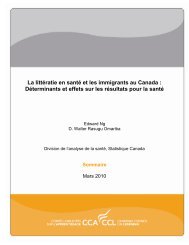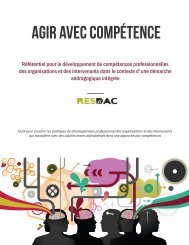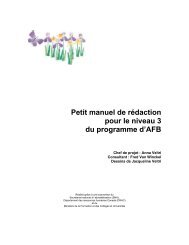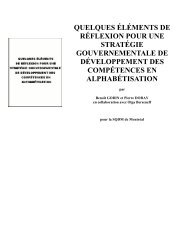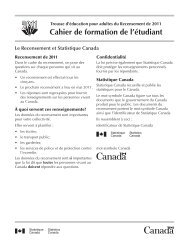Apprentissage informel lié au travail - Base de données en ...
Apprentissage informel lié au travail - Base de données en ...
Apprentissage informel lié au travail - Base de données en ...
- No tags were found...
You also want an ePaper? Increase the reach of your titles
YUMPU automatically turns print PDFs into web optimized ePapers that Google loves.
RéFéRENCESCÉT. (2006). WILM (Workplace Informal Learning Matrix — MAIT(Matrice <strong>de</strong> l’appr<strong>en</strong>tissage <strong>informel</strong> <strong>en</strong> milieu <strong>de</strong> <strong>travail</strong>).Consulté le 8 octobre 2008 sur www.wilm.ca.Church, K., Frazee, C., Panitch, M., Luciani, T. et Bowman, V.(2008). Doing disability at the bank : Discovering the work ofinformal learning/teaching done by disabled bank employees.In D. Livingstone, K. Mirchandani et P. Sawchuk (dir.), The futureof lifelong learnig and work : Critical perspectives (p. 147-153).Rotterdam : S<strong>en</strong>se.Clover, D. et Hall, B. (2000). In search of social movem<strong>en</strong>t learn-ing : The Growing Jobs for Living Project (NALL Working PaperNo. NALL-WP-18-2000). Toronto : Institut d’étu<strong>de</strong>s pédagogiques<strong>de</strong> l’Ontario.CMEC. (2005). Developing an adult education policy framework: Terminology, typology and best practices (Élaborationd’un cadre stratégique pour l’éducation <strong>de</strong>s adultes : terminologie,typologie et meilleures pratiques). Ottawa : Ressourceshumaines et Développem<strong>en</strong>t <strong>de</strong>s compét<strong>en</strong>ces Canada.CMEC. (2007). Recognition of non-formal and informal learn-ing (RNFIL) (La reconnaissance <strong>de</strong> la formation non formelle et<strong>informel</strong>le : rapport <strong>de</strong>s activités provinciales et territoriales etvue d’<strong>en</strong>semble pancanadi<strong>en</strong>). Ottawa.Cole, M. (2004). The practice of <strong>de</strong>veloping practice : facilitatingthe capture and use of informal learning in the workplace.Work <strong>Base</strong>d Learning in Primary Care, 2, 1-5.Cole, M. (2005). The exam first, the lesson afterwards : an explorationand celebration of the nature of informal learning.Work <strong>Base</strong>d Learning in Primary Care, 3, 325-338.Colley, H., Hodkinson, P. et Malcolm, J. (2002). Non-formallearning : mapping the conceptual terrain. A Consultation Report.Leeds : University of Leeds Lifelong Learning Institute.Colley, H., Hodkinson, P. et Malcolm, J. (2003a). Informality andformality in learning : a report for the Learning and Skills ResearchC<strong>en</strong>tre. Londres : Learning and Skills Research C<strong>en</strong>tre.Colley, H., Hodkinson, P. et Malcolm, J. (2003b). Un<strong>de</strong>rstandinginformality and formality in learning. Adult learning,8-11 novembre.Commission europé<strong>en</strong>ne. (2001, 11 juillet 2007). Communication: Making a European area of lifelong learning a reality (Communication: Réalisation d’un espace europé<strong>en</strong> <strong>de</strong> l’éducation et<strong>de</strong> la formation tout <strong>au</strong> long <strong>de</strong> la vie). Consulté le 10 octobre2008 sur http://ec.europa.eu/education/policies/lll/lll_<strong>en</strong>.html.Cross, J. (2006, 14 août 2008). What is Informal Learning.Informal Learning Blog Consulté le 20 mai sur http://informl.com/2006/05/20/what-is-informal-learning/.Cross, J. (2007). Informal learning : Rediscovering the naturalpathways that inspire INNOVATION and PERFORMANCE. NewYork : John Wiley et Sons.Davou, B. (2002). Unconscious processes influ<strong>en</strong>cing learning.Psychodynamic Practice, 8(3), 277-294.Dawson, M. (2008). The Value of Informal Learning inthe Workplace (Case study). Consulté le 29 juillet 2008 surwww.partnershipsinlearning.ca/Formal_informal/text/Case%203_Elmsdale.pdf.Delage, B. (2002). Results from the L’Enquête sur le <strong>travail</strong> indép<strong>en</strong>dantin Canada (Résultats <strong>de</strong> l’Enquête sur le <strong>travail</strong> indép<strong>en</strong>dant<strong>au</strong> Canada). (No. RH64-11/2001E). Hull, Québec :Développem<strong>en</strong>t <strong>de</strong>s ressources humaines Canada.Delhi, K. et Fumia, D. (2002). Teachers’ informal learning, i<strong>de</strong>ntityand contemporary education reform (analyses d’informationNo. NALL-WP-56-2002). Toronto : Institut d’étu<strong>de</strong>s pédagogiques<strong>de</strong> l’Ontario.Destré, G. et Nordman, C. (2002). Les effets <strong>de</strong> la formation <strong>informel</strong>lesur les gains : une comparaison sur <strong>données</strong> appariéesfrançaises, marocaines et tunisi<strong>en</strong>nes. L’Actualité économique78(2), 179-205.English, L. (2002). Learning how they learn : International adulteducators in the global sphere. Journal of Studies in InternationalEducation, 6(3), 230-248.Er<strong>au</strong>t, M. (2000). Non-formal learning, implicit learning and tacitknowledge. Dans F. Coffield (dir.), The necessity of informallearning. Policy Press.F<strong>au</strong>connier, G. et Turner, M. (2002). The way we think : Conceptualbl<strong>en</strong>ding and the mind’s hid<strong>de</strong>n complexities. New York :Basic Books.F<strong>en</strong>wick, R. (2008). Workplace learning : emerging tr<strong>en</strong>ds andnew perspectives. New Directions for Adult and ContinuingEducation, 119, 17-26.F<strong>en</strong>wick, T. (2001). Work knowing “On the Fly” : <strong>en</strong>terprisecultures and co-emerg<strong>en</strong>t epistemology. Studies in ContinuingEducation, 23(2), 243-259.F<strong>en</strong>wick, T. (2006). Tidying the territory : questioning termsand purposes in work-learning research. Journal of WorkplaceLearning, 18(5), 266-278.Fitzgerald, R., Taylor, R. et La Valle, I. (2002). National AdultLearning Survey (NALS) 2002. Londres : National C<strong>en</strong>tre for SocialResearch.Fuller, A., Ashton, D., Felstead, A., Unwin, L., Walters, S. etQuinn, M. (2003). The Impact of Informal Learning at Work onBusiness Productivity. Leicester, UK : University of Leicester, C<strong>en</strong>treFor Labour Market Studies.Gairey, J., Ng, W., Martin, D. A. et Jackson, N. (2006). The chall<strong>en</strong>gesof educating for equality in unions. Consulté le 13 juin2008 sur http://wallnetwork.ca/resources/jackson_Ng_Chall<strong>en</strong>gesof Educating Equality2006.pdf.Garvin, D., Edmondson, A. et Gino, F. (2008). Is yours a learningorganization ? Harvard Business Review, (mars), 109-118.Gladwell, M. (2000). The tipping point : How little things canmake a big differ<strong>en</strong>ce. New York : Little, Brown and Company.50









